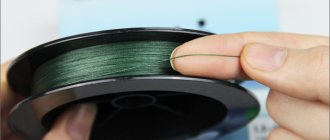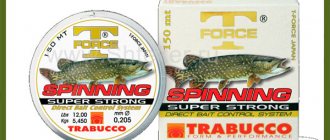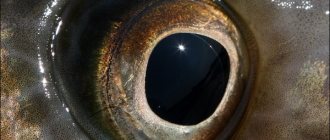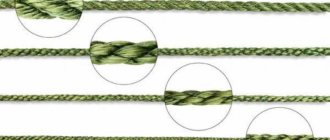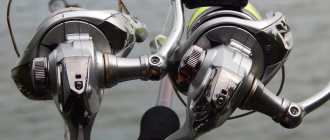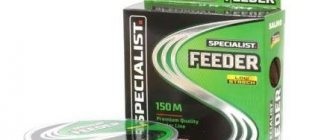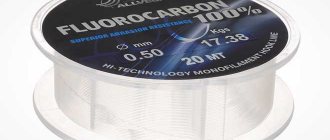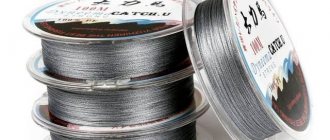Having chosen a spinning rod and selected a reel for it, the angler is faced with another issue - the choice of fishing line. Solving this problem is not difficult, because there are a huge number of fishing products on our market, and even the most biased spinning angler will be able to find something suitable. It is more difficult to understand the fundamental question of which fishing line is better for spinning: monofilament or braid. It is this question that in recent years has become one of the main stumbling blocks in the choice of spinning gear. So, let's look at the main characteristics of one and the second type of fishing line. Which fishing line is best for spinning is up to everyone to decide personally.
Background
Braided fishing line appeared on our market just a few years ago. Spinners immediately began testing the new product. Some of them were delighted with it and immediately abandoned the traditional monofilament line. The other part reacted extremely skeptically to the new product, complaining about a number of its obvious shortcomings. Thus, to this day there is no strong opinion about whether braided line is capable of fully replacing monofilament line. Each type of fishing line has its own advantages and disadvantages. Therefore, spinners have to choose which disadvantage to ignore and which advantage to take advantage of. So the question: “Which fishing line is best for spinning?” is incorrect, since each type has the right to exist. Now we will make sure of this.
Rating of the best fishing lines for spinning
If we review the best fishing lines, we can note some of them that have successfully proven themselves in different conditions and are used by anglers for many seasons. Among the monofilas, the following can be distinguished:
Antares Silk Shock, Technium Spinning Line - manufacturer Shimano. Owner fishing line from the company of the same name. There are several varieties of it - Broad, Broad Carp Special, Blue Eye, Broad Game Pro, Fluorocarbon. New Super FC Sniper and FC SWS Small game - produced by Sunline. Fluorocarbon lines. Super Soft is a manufacturer of Phantom Line. RXR Kameleon is made by Balsax.
Production
Monofoles are made from all kinds of nylon copolymers by extrusion. The quality of the product is determined by the composition of the material, its processing technology, calibration accuracy and a number of other technological factors.
Braided fishing lines are made by weaving together thin fibers of all kinds of high-strength materials. Most often they are woven from polyester and aramid fibers.
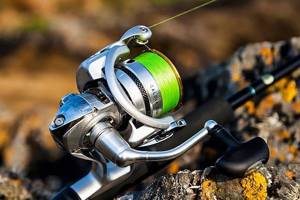
What diameter of feeder line should I put on the feeder?
As for the diameter of the fishing line, everything is quite simple. The thicker the line, the stronger it is, so we compare the diameters of cords from the same manufacturer. The heavier the equipment being cast, the further away the fishing spot and the larger the expected fish, the correspondingly thicker the fishing line should be.
But you should always try to put the line as thin as possible, because the thickness of the line section determines how much the line will be washed away by the current and wind, and the angler will have to use an even heavier feeder. In this case, the tackle becomes coarser and heavier, which affects the biting activity of cautious fish. That’s basically all a feeder needs to know about choosing monofilament and braided lines when fishing on a feeder.
If you want to find out useful information about the choice and types of feeder feeders, for example, for currents, muddy bottoms, or long-distance casting, we recommend that you read our article here.
Monofilament fishing line: advantages
The first thing worth noting is its high strength. And if you add elasticity to it, you get an excellent product for confidently fighting large fish. Thanks to its elasticity, monofilament absorbs fish impacts and prevents breakage. Since this type of fishing line has a minimal coefficient of friction, it allows you to make a long throw. The point is that when it comes into contact with the rod's guides, the line does not lose speed. By the way, some models even have a special surface layer consisting of fluoroplastic molecules, which allows for maximum friction reduction.
If you regularly fish on reservoirs with snags or rocky bottoms, the fishing line will last for quite a long time, because it is highly resistant to abrasion. Another important characteristic of monofilaments is that they are transparent (of course, with the exception of special colored models) and invisible in the water.
The monofilament has a perfectly round cross-section, so it is calibrated with maximum accuracy. For the same reason, the product is evenly placed on the reel. Most monofilament lines are made from a material whose density is greater than that of water, so the line sinks.
At subzero temperatures, the fishing line does its job well - it does not rub against the edges of the hole and does not freeze. The price of monofilament ranges from 0.5 to 7 dollars per 100 meters.
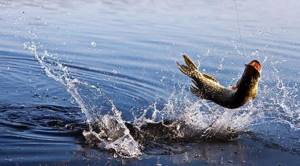
What types of fishing lines are there for spinning rods?
The best fishing line for spinning is different for each angler. However, for beginners it will be useful to know how fishing lines differ according to the material they are made of. There are all types of fishing line for spinning fishing:
This is the simplest smooth nylon thread with a round cross-section. It is used as a main or leader line. Monofilament fishing line is installed mainly on a spinning rod used as a casting rod. Also used for catching predators in the absence of braided cord. It justifies itself in cases where increased strength characteristics are not required, and casting range is not critically important.
Braided fishing line: advantages
We continue to deal with the question of which fishing line is best for spinning. Now it's time to discuss braided line. So, the first and main advantage of the braid is its colossal strength. It is determined by the structure of the fishing line. The so-called broom effect works here - breaking one twig is easy, but breaking a broom is almost impossible. Unlike monofilament, braided line is not elastic. This is good in the sense that it allows you to better experience everything that is happening at the other end of the tackle, namely the play of the bait, the bottom topography and, of course, the strikes of the fish. This feature also has a positive effect on the rigidity of the hook. Braided fabric is quite resistant to abrasion and all kinds of mechanical stress. In this regard, it lasts longer than monofilament.
A thin cord can withstand the same load as a thick fishing line. Therefore, the braid is always thinner. This is another important advantage of this type of fishing line. This feature not only makes the product less noticeable in the water, but also has a positive effect on casting. The reason for this is simple: the thinner the thread, the less windage it has in the wind.
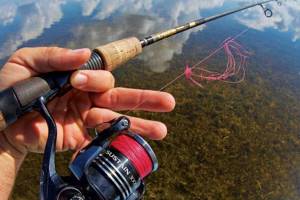
Line selection
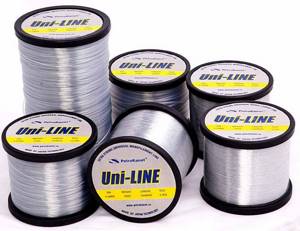
Depending on the gear used
To catch a predator using spinning tackle, it is recommended to use high-quality braided cord, and monofilament or fluorocarbon as the leader material.
It is better to equip a float fishing rod with a monofilament fishing line with a cross-section of 0.4 mm. In this case, it is advisable to make the leashes from a metal material, strings. This type of leader is also suitable for fluorocarbon main line.
For jig tackle, the best option is to use braided line as the main line.
Depending on fishing conditions
Taking into account the peculiarities of pike habitats - thickets of grass and snags, it is rational to use a braided cord.
For fishing in clean waters, monofilament fishing line and fluorocarbon thread will do just fine.
Braided line: disadvantages
Let's start with the fact that braided fishing line is inelastic. This has its advantages, as mentioned above, but there are also some disadvantages. The fact is that braid cannot absorb shocks, which means the likelihood of the gear breaking increases. In addition, due to this property, the load on the rod and reel increases during fishing. Therefore, if you fish with braid, be sure to take care of fine-tuning the clutch.
The next disadvantage of the cord is that it is quite soft when applied in the transverse direction. But this, as mentioned above, does not prevent him from being resistant to damage. The coefficient of friction for this type of fishing line is quite high, so during casting it is slightly slowed down by the rings. Braid is never transparent. Its color range can range from dull to fluorescent colors.
For many braided lines, there are only a few suitable types of knots that, when tied, will allow the line to withstand the load placed on it. Otherwise, it will come untied or even break. As a rule, suitable components are indicated schematically on the box or annotation for the product. Due to its thinness and softness, the cord often “bears.” And, as a rule, it is not possible to untie the beard.
Another problem with braided fishing lines is the lack of accurate calibration. Some of the cords, due to the specific weaving, have not a round, but an ellipsoidal or even flat cross-section. And even braids with a round cross-section can shrink, so measuring the diameter of such lines is always problematic. But on the other hand, there is no particular need for ultra-precise measurement of the diameter of such products. They are very durable, so there is no need to find fault with the diameter indicated on the box. If it is written that the cord can withstand a certain weight, it is so.
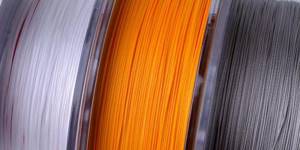
Main Factors
The main advantages of the cord are its strength and lack of elongation, which makes the equipment as sensitive as possible. With the same diameters as the fishing line, the braided line is stronger, but there are cases when you need to use the minimum diameter. The fishing line has an elongation of up to 15%, and the fisherman can also use this to his advantage. Let's take a closer look at the pros and cons of cord and monofilament lines.
Catching distance
It makes sense to use fishing line when fishing at a maximum distance of 40 meters from the shore, and better yet at 25–30 meters. After 40 meters, the fishing line is already much inferior to the cord in sensitivity, and you run the risk of missing out on a lot of bites, which will cause the sales and, accordingly, the final catch to suffer. When fishing at long distances, it will be difficult to hook fish using monofilament, and there is no point in taking risks.
Current strength
Also use braided line during the current, as it allows you to use a smaller diameter than fishing line, and at the same time it will be stronger. But speaking of flow, the main role is played by the diameter. The smaller the diameter, the better the cord “cuts” the water, which means less water resistance is created. This allows you to use lighter feeders and make the equipment more sensitive. As a result, delicate equipment can play a decisive role in successful fishing.
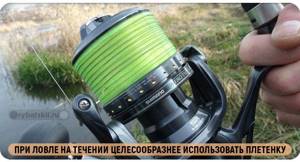
Type of fish and its size
Since braided cord is stronger than monofilament, it is logical that to catch large fish and trophies you should use braid, but here everything is just the opposite. Due to its minimal stretch and rigidity, it is difficult to fish for trophies with braided line and the chances that the fish will escape are high. With strong jerks, the fish will tear its lip and leave. This is true when fishing for carp on a feeder, carp, carp, ide, chub and even large crucian carp. When catching this fish, it is better to choose a fishing line that will absorb jerks when fishing and the chances of bringing the catch to the landing net increase.
When using a cord while fishing, you can actively work with the friction and this will increase the chances of catching fish. However, experience is already needed here, and it is not a fact that the fish will be able to be brought ashore.
When fishing for white bream and standard bream, you can safely use a feeder cord.
Fishing at sub-zero temperatures
But if you are a fan of feeder fishing in winter at sub-zero temperatures, then fishing line is better suited here. It doesn’t freeze as much as braided line and fishing will be much more comfortable. Especially if fishing takes place at temperatures below – 10, when impregnation of the cord with various means will not bring the desired result. Therefore, install monofilament in winter.
New generation of braided lines
It is worth highlighting the latest generation of cords. They are professional fishing lines made from ultra-high molecular weight polyethylene. This type of fishing line can truly become a revolutionary product in the world of fishing tackle. Here are its main properties:
- Low coefficient of friction (even lower than monofilament threads).
- Precise calibration.
- Increased durability.
- Excellent softness.
- The strength has become slightly lower than that of simple braids, but it can be preserved after long-term use.
- High cord density. This means that it captures fewer abrasive particles from the water and does not wear out the rod rings.
- Such fishing lines are knitted only with special knots.
- Typically, a new generation of braiding is a round cord, knitted from many very thin threads.
- The main disadvantage is the high price. The new generation braid costs from 25 to 60 dollars per 100 meters. By the way, a simple braid costs $8-30 per 100 m.
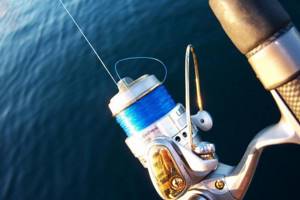
Which fishing line is best for spinning for pike and perch, trout and pike perch?
For pike and pike perch (these species grow to approximately the same size), a fishing line with a diameter of 0.22 to 0.35 mm is quite suitable. It will allow you to easily pull out fish up to 7 kilograms. You can find out in more detail which fishing line is best for a spinning rod for pike (diameter, manufacturer, color, etc.) from the seller. As for the cords, braid with a diameter of up to 0.25 mm is quite suitable for such fish (it will definitely withstand about 7-8 kilograms). Answering the question of which fishing line is best for spinning for trout, we can name, in principle, the same range of diameters as for pike and pike perch.
Another thing is perch. Since this comrade does not grow more than 2 kilograms, it is not at all necessary to have a thick fishing line to catch it. Monofilament or braid with a diameter of 0.16-0.2 mm will be sufficient. And you can take even thinner braid, but, by and large, there is no point in this.
Types and characteristics of fishing lines
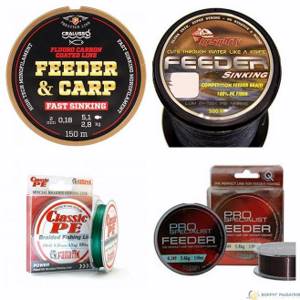
There is a significant difference in the choice of fishing line for fishing in a current and a standing reservoir, when fishing for roach, bream or carp, and you should purchase one or another model of fishing line only taking into account all the relevant circumstances.
Modern milkers use three types of fishing line:
- monofilament;
- wicker;
- fluorocarbon.
Just a couple of decades ago, fishermen only dreamed of such a choice, because there was no alternative to monofilament fishing line in stores. Thanks to military developments and the introduction of new technologies, fluorocarbon was invented, which is gaining great popularity among feeders around the world.
Feeder braid has also taken its rightful place and is preferred to be used in different conditions both in competitions and during amateur fishing.
The line for the feeder is characterized by the following factors:
- diameter;
- rigidity;
- extensibility;
- strength;
- breaking load on the node;
- color;
- buoyancy;
- material of manufacture;
- cost.
Expert opinion
Evgeny Zhirkov
Feeder fishing expert
Inexperienced fans of English donkey, when choosing a monofilament line for a feeder, primarily focus on the breaking load, without paying attention to other characteristics, and as a result make a mistake.
Considering what kind of fish is caught on the feeder, other characteristics of the fishing line sometimes come to the fore. In particular, this concerns the rigidity, diameter and color of the monofilament, which affect the casting distance and camouflage qualities.
When catching trophy fish, the fishing line really should be high-strength, but the main catch is still small fish and therefore the strength of the knot is not a determining factor.
Bream or crucian carp, and even more so roach, are caught on a line with a diameter of 0.14-0.2 mm and there is no point in using a thick base that will only unmask the equipment.
When fishing in strong currents, select a fishing line of the smallest possible diameter that does not create additional resistance to the flow of water.
The sensitivity of the feeder equipment largely depends on the weight of the feeders and it is desirable that it be as small as possible.
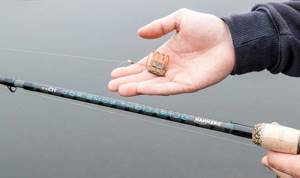
But light feeders are more easily carried away by the current, and by choosing a thin line, the angler solves the problem. It is easier to cast equipment with a thin base over a long distance, so in this case the diameter is more important.
When fishing in spring, in clear water, when there is still little grass in the rivers, the color of the monofilament is very important, because fish are wary of unfamiliar and incomprehensible objects.
Transparent or light green monofilament line in such a situation turns out to be the most invisible, which also has to be taken into account. The monofilament sinks better and faster, delivering the feeder to a given point and providing additional camouflage.
Highlighting the advantages of monofilament fishing line for a feeder, we note that it:
- sinks faster;
- has a homogeneous structure;
- costs less than cord or fluorocarbon;
- invisible in the water column;
- has stretchability, which is important when catching trophy fish;
- smooth and does not interfere with slippage in the quivertype rings.
When fishing for trophies, the feeder rod absorbs the jerks of the fish, and the use of the reel clutch provides convenience in working with the equipment. But the stretchability of monofilament fishing line also plays an important role, and, for example, when fishing using the feeder method, braid is practically not used.
A strong fish, of course, will not break the wicker base, but because of its inextensibility, derailments happen quite often, and you want to avoid them. Relatively low cost and a large assortment are also among the advantages of monofilament feeder fishing line, and this is especially important for amateurs and novice feeders.
True, the stretchability of monofilament fishing line when fishing for small fish is rather a drawback that affects the sensitivity of the equipment, and the choice in favor of braided line in such cases is justified.
Among other disadvantages of monofilament, we highlight:
- low breaking load;
- fragility.
Since you have to fish both under the scorching sun and in heavy rain, the negative impact of ultraviolet radiation or moisture on monofilament fishing line is very significant. During the fishing season it has to be changed, which leads to additional costs, so you have to forget about saving.
Don’t forget about the rigidity of monofilament fishing line, because soft materials have a “memory” and very quickly become unusable, twist and curl. A high-quality monofilament base has a shiny surface, but if it is matte, it means it was not stored correctly, or due to long-term storage it has lost its best properties.
When purchasing, you should check the breaking load on the knot by first wetting it, because when the knot is tightened, the dry line gets very hot and will break faster. A good monofilament line has the same diameter along its entire length, which makes long-distance casting easier. This is not always noticeable to the eye, but you need to be careful, and all possible flaws will definitely be revealed.
You should not pay attention to those monofilament lines that have an increased breaking load. On average, for a fishing line with a diameter of 0.28 mm it is 5-7 kg.
Unscrupulous manufacturers indicate an overestimated breaking load, which misleads fishermen.

